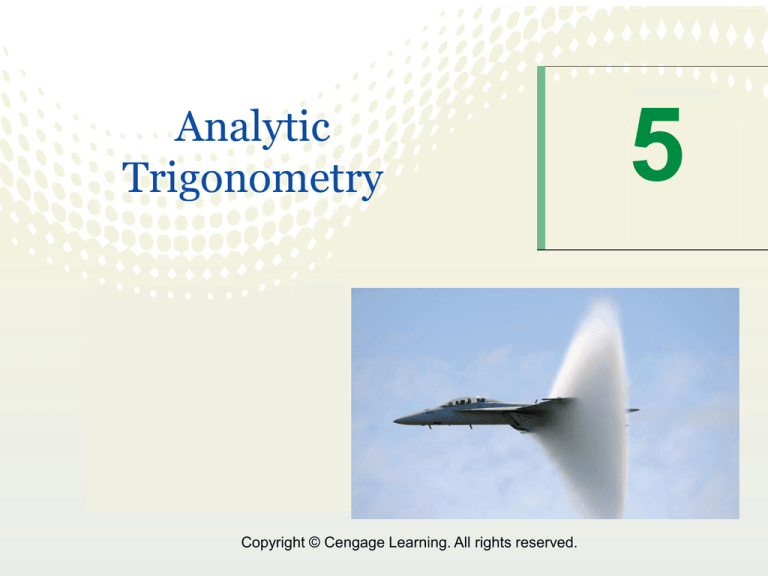
Analytic
Trigonometry
Copyright © Cengage Learning. All rights reserved.
5
More…
Find all solutions of the equations in the interval [0,2𝜋)
1. cos(𝑥 −
𝜋
)
2
+ sin2 𝑥 = 0
2. tan(𝑥 + 𝜋) + 2 sin(𝑥 + 𝜋) = 0
Write the trigonometric expression as an algebraic
expression:
sin(arctan 2𝑥 − arccos 𝑥)
2
5.5
MULTIPLE-ANGLE AND PRODUCT-TO-SUM FORMULAS
Copyright © Cengage Learning. All rights reserved.
Multiple-Angle Formulas
4
Example 1 – Solving a Multiple-Angle Equation
Solve 2 cos x + sin 2x = 0.
Solution:
2 cos x + sin 2x = 0
2 cos x + 2 sin x cos x = 0
2 cos x(1 + sin x) = 0
2 cos x = 0 and 1 + sin x = 0
5
Example 3: Evaluating Functions Involving Double Angles
Use the cos 𝜃 =
5 3𝜋
,
13 2
< 𝜃 < 2𝜋 to find sin 2𝜃 , cos 2𝜃 , tan 2𝜃
Solution:
5 3𝜋
5
cos 𝜃 =
,
< 𝜃 < 2𝜋 ⇒ sin 𝜃 = − 1 −
13 2
13
2
5
120
sin 2𝜃 = 2 sin 𝜃 cos 𝜃 = 2 −
=−
13 13
169
5
cos 2𝜃 =
−1=2
13
sin 2𝜃 120
tan 2𝜃 =
=
cos 2𝜃 119
2 cos 2 𝜃
2
2
2
=−
13
119
−1=−
169
6
Power-Reducing Formulas
cos 2𝑢 = 2 cos2 𝑢 − 1 = 1 − 2 sin2 2𝑢 = cos2 2𝑢 − sin2 2𝑢
7
Example 5 – Reducing a Power
Rewrite sin4 x as a sum of first powers of the cosines of
multiple angles.
Solution:
8
Half-Angle Formulas
9
Example 6 – Using a Half-Angle Formula
Find the exact value of sin 105.
Solution:
10
Product-to-Sum Formulas
11
Product-to-Sum Formulas
12
Example 8 – Writing Products as Sums
Rewrite the product cos 5x sin 4x as a sum or difference.
Solution:
cos 5x sin 4x = (½) [sin(5x + 4x) – sin(5x – 4x)]
= (½ ) (sin 9x – sin x)
13
Product-to-Sum Formulas
14
Example 9
Find the exact value of cos 195° + cos 105°
Solution:
cos 195° + cos 105°
195° + 105°
195° − 105°
= 2 cos
cos
2
2
= 2 cos 150° cos 45°
3
=2 −
2
2
6
=−
2
2
15
Example 11
Verify the identity
sin 3𝑥−sin 𝑥
cos 𝑥+cos 3𝑥
= tan 𝑥
Proof :
3𝑥 + 𝑥
3𝑥 − 𝑥
2 cos
sin
sin 3𝑥 − sin 𝑥
2
2
=
cos 𝑥 + cos 3𝑥 2 cos 𝑥 + 3𝑥 cos 𝑥 − 3𝑥
2
2
2 cos 2𝑥 sin 𝑥
=
2 cos 2𝑥 cos(−𝑥)
=
sin 𝑥
cos 𝑥
= tan 𝑥
16
Application
17
Example 12 – Projectile Motion
Ignoring air resistance, the range of a projectile fired at an
angle with the horizontal and with an initial velocity of
v0 feet per second is given by
where r is the horizontal distance (in feet) that the projectile
will travel.
18
Example 12 – Projectile Motion
cont’d
A place kicker for a football
team can kick a football from
ground level with an initial
velocity of 80 feet per second
(see Figure 5.18).
Figure 5.18
a. Write the projectile motion model in a simpler form.
b. At what angle must the player kick the football so that
the football travels 200 feet?
c. For what angle is the horizontal distance the football
travels a maximum?
19
Example 12 – Solution
a. You can use a double-angle formula to rewrite the
projectile motion model as
r=
=
b.
r=
200 =
v02 (2 sin cos )
Rewrite original projectile motion model.
v02 sin 2.
Rewrite model using a double-angle formula.
v02 sin 2
Write projectile motion model.
(80)2 sin 2
Substitute 200 for r and 80 for v0.
20
Example 12 – Solution
200 = 200 sin 2
1 = sin 2
cont’d
Simplify.
Divide each side by 200.
You know that 2 = / 2, so dividing this result by 2
produces = / 4.
Because / 4 = 45, you can conclude that the player must
kick the football at an angle of 45 so that the football will
travel 200 feet.
21
Example 12 – Solution
cont’d
c. From the model r = 200 sin 2 you can see that the
amplitude is 200. So the maximum range is r = 200 feet.
From part (b), you know that this corresponds to an
angle of 45.
Therefore, kicking the football at an angle of 45 will
produce a maximum horizontal distance of 200 feet.
22
Introduction
Oblique triangles—triangles that have no right angles.
Law of Sine
1. Two angles and any side (AAS or ASA)
2. Two sides and an angle opposite one of them
(SSA)
Law of Cosine
3. Three sides (SSS)
4. Two sides and their included angle (SAS)
23
Introduction
24
Example 1 – Given Two Angles and One Side—AAS
For the triangle in figure, C = 120, B = 29, andb = 28 feet.
Find the remaining angle and sides.
Solution:
The third angle of the triangle is
A = 180 – B – C
= 180 – 29 – 102
= 49.
.
25
Example 1 – Solution
The third angle of the triangle is
A = 180 – B – C
= 180 – 29 – 102
= 49.
By the Law of Sines, you have
.
26




